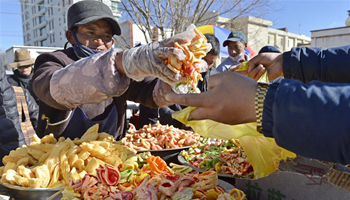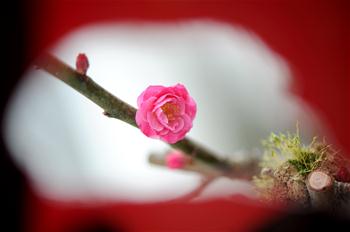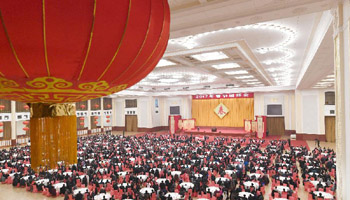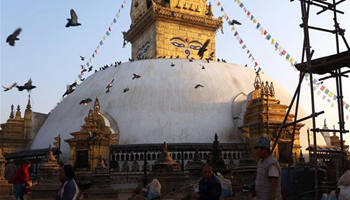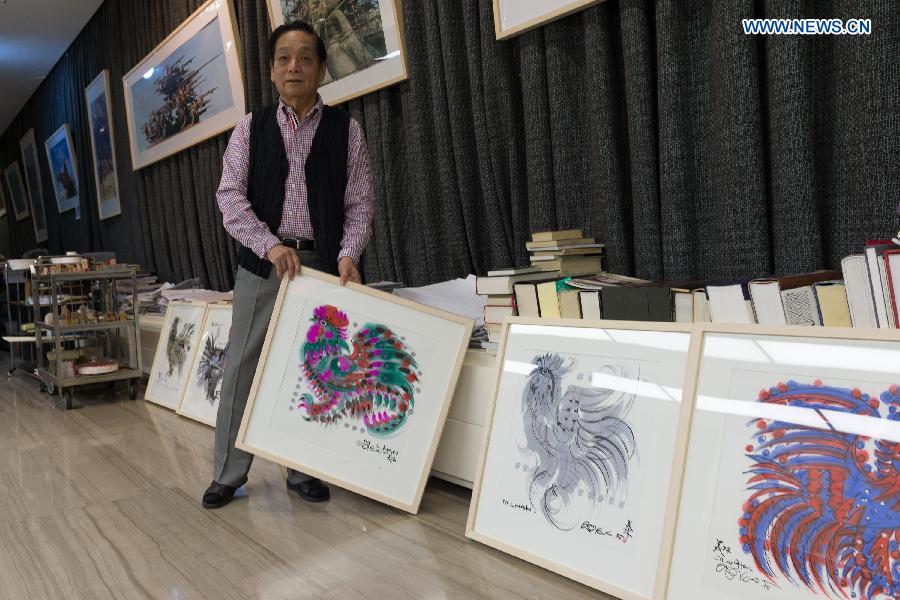
Chinese artist Han Meilin, 80, shows his paintings of roosters and hens at his studio in eastern district of Tongzhou in Beijing, capital of China, Jan. 24, 2017. Han, designer of the 2008 Beijing Olympic Games mascot "Fuwa," has just finished the design of Chinese zodiac stamps for the upcoming Year of the Rooster. The set of Chinese Lunar New Year rooster stamps, issued earlier this month, contain two items showing a rooster striding proudly and a hen looking after her two chicks. Han applied rich color and elements of traditional Chinese painting to depict a happy family of roosters and hens. (Xinhua/Wu Kaixiang)
By Xinhua writers Liu Xin, Wu Kaixiang
BEIJING, Jan. 26 (Xinhua) -- The 80-year-old designer of the 2008 Beijing Olympic Games mascot "Fuwa," Han Meilin, has just finished a new job. He designed Chinese zodiac stamps for the upcoming Year of the Rooster.
"In Chinese culture, the rooster stands for good luck and happiness," Han said, while showing his designs at his studio in eastern Beijing's Tongzhou District.
A set of Chinese Lunar New Year rooster stamps were issued earlier this month at the price of 2.4 yuan for two items, as designed by Han.
He applied rich color and elements of traditional Chinese painting to depict a happy family of roosters and hens. This year's Chinese zodiac stamps contain two items, one portrays a rooster striding proudly, the other shows a hen looking after her two chicks.
A grand exhibition of Han's work has been held in the National Museum of China since December 2016. Both stamp images come from a painting called "a hundred roosters and hens".
"I have drawn more than one thousand pictures of roosters and hens for preparation of the exhibition and Lunar New Year stamp design," Han said during an exclusive interview with Xinhua.
"The rooster is one of 12 signs of the Chinese zodiac, pronounced 'Ji' in Chinese, same as the word 'auspicious,'" he said. "So all Chinese people around the world like it."
"Chinese Lunar New Year could be the biggest festival on the planet since it influences such a big crowd of people," Han said, pointing out that the stamps represent of Chinese culture.
He tried combining linear drawing method with ink-wash, an East Asian type of brush painting. The artworks show the roosters in different postures, full of spirit.
Han's story with roosters does not begin with the Lunar New Year stamps.
"I have drawn numerous roosters, hens and chickens in my life," he said.
Han selected five sample paintings and gave them to China Post, the domestic producer of the Chinese zodiac stamps.
"Finally two of them have made their appearance with people."
He believes that a small stamp is attractive, epitomizes a country's culture and reflects its prosperity.
"I am also a stamp collector," he said, "not just a designer."
Since college, Han has been collecting stamps from different countries.
"Both knowledge and beauty can be found on the patterns of stamps," he said.
In 1980, the Year of the Monkey, China issued its first zodiac stamp. Three years later, Han designed the pig year stamp.
"I drew about 30 pictures of pigs that year." Han said. He has made greater efforts to design better rooster stamps this time.
There have been more than 30 artists engaged in zodiac stamp design since 1980, according to Gao Shan, distribution manager of China Post.
"Some other Asian countries started issuing zodiac stamps earlier than China," Gao said. "I think it is an important progress for the country's post industry."
"The Chinese zodiac is becoming more widely recognized all over the world," he said.
Gao believes that the stamps are important for spreading Chinese culture, but acknowledges that drawing zodiac stamps differs from the regular drawing of animals.
"Artists ought to create figures full of cheerful atmosphere and traditional Chinese culture, based on the careful observation of animals," Gao said. "The publisher and artist sometimes hold different standards of the stamp design."
The final published versions are a product of negotiation between China Post and the artists.
Han is a professor at Tsinghua University, and also the deputy director of the university's academic committee. In 2015, Han became the first Chinese artist to be designated as a UNESCO Artist for Peace.
Recognized as a painter, sculptor and designer, he has established three art museums in Beijing, Hangzhou in eastern China's Zhejiang Province, and Yinchuan in northwest China's Ningxia Hui Autonomous Region.
In October last year, Han started his global touring art exhibition in Venice, Italy. The exhibition at the National Museum of China is the second stop. Paris will be the third, this March.
There are no signs of fatigue or burnout on Han's face, despite devoting tens of years to creating art. He still draws every day.
"I just hope to depict this beautiful world," Han said. "And wish people a happy Chinese Lunar New Year."




